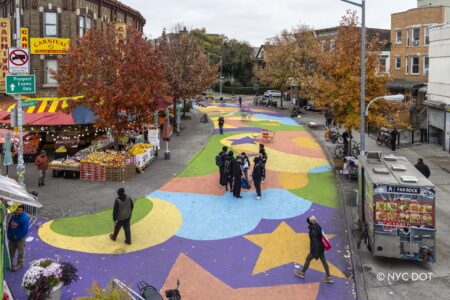
Misha Tyutyunik’s “Conversation at Beverly” mural located in Kensington Pedestrian Plaza. Image Credit: NYC DOT/Misha Tyutyunik.
By Mark Chiusano
For obvious reasons I was recently revisiting a small controversy over the usage of public space in a certain midtown Manhattan building: Trump Tower.
In 2016, Donald Trump and New York City went back and forth over whether the building had to keep some public benches in the lobby. During construction decades earlier, the tower had been allowed to rise higher in exchange for a little bit of public space (some of it not easy to find), and that originally included seating.
This is not an article about Trump or even the controversial concept of Privately Owned Public Spaces (POPS) that he and other developers have long leveraged. But the bench saga is an example of one way that fights over public spaces often go in New York, with advocates pushing to add to or at least preserve the available geography open to all.
A different way to improve public space is through creating jobs. That’s the argument nestled in a new report on public realm management from the livable streets nonprofit Open Plans, which among many other ideas proposes that the city pay approximately 2,900 New Yorkers for “stewardship work” across the five boroughs, tending to sidewalks, plazas, Open Streets, and other under-managed public spaces.
The idea is that if a nominally nice public zone is not taken care of, “it becomes so much less successful,” said Jackson Chabot, the organization’s director of advocacy and organizing.
Open Plans envisions a small army of contracted workers, many paid by community groups through city funding, who could do extra cleaning like wiping surfaces, removing empty bottles from tree beds, and cleaning up notorious litter spots that attract rats. The new “public space teams,” one for each of the city’s 59 community districts, could also include personnel to serve as liaisons with city agencies, doing localized surveys, helping to establish loading zones, and landing resources for Open Streets or block parties. In little plazas and other hospitable areas, the workers could set up and take down tables and chairs, a simple action that significantly changes a landscape.
“People will sit effectively in the middle of traffic if you put out a table and chair there, but otherwise it just is like a slice of concrete,” Chabot noted.
In some parts of the city, particularly commercial areas, this work is taken on by local groups like business improvement districts (BIDs). The Open Plans report also notes there is a model for contractors providing extra touchup sanitation. Over 140 full-time public space workers with the Association of Community Employment Programs for the Homeless collected 14 million pounds of trash in 2023, and the city already partners with outfits like the Horticultural Society of New York for public space management.
Expanding these efforts would ensure areas don’t fall through the cracks, but Chabot also likened a wider jobs program to ambitious national efforts such as the Depression-era Works Progress Administration, which would change “how we think about what it means to invest in people and invest in our space that we share.”
Such ideas have become popular in Democratic circles in recent years, from former Mayor Bill de Blasio’s City Cleanup Corps to the civilian climate corps pushed by the likes of President Joe Biden and Rep. Alexandria Ocasio-Cortez.
All this would add to a body of evidence that finds economic benefits from bustling, well maintained public spaces – like the early pandemic-era Open Streets corridors that boosted businesses, according to a Department of Transportation report in 2022.
Open Plans has been pitching City Council members and other city government stakeholders on their jobs plan, the full version of which could cost $320 million in annual spending, or less than 0.3% of the city’s budget, according to the September report. This outreach is in early stages and will hardly win over everyone – City Council Member Joe Borelli, the Republican minority leader, suggested it was “unclear” why more labor was needed given the city’s many employees.
But Chabot contends that there would be benefits from stewards in each community district, arguing that a lot gets overlooked in too many neighborhoods given the already-strapped portfolios of agencies like Parks and Sanitation. And he thinks that residents would make more use of spaces that have more to them than a trash-fluttering expanse.
“I mean, New Yorkers will literally sit on top of a fire hydrant, for example, if it’s the only place to sit,” he said. “We’re craving more public space.”
***
Mark Chiusano is a Senior Fellow in New York Law School’s Center for New York City and State Law and the author of The Fabulist: The Lying, Hustling, Grifting, Stealing, and Very American Legend of George Santos.

